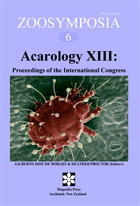Abstract
The objective of this work was to evaluate the effect of acaricide applications and pruning of symptomatic branches in citrus leprosis management in Brazil. It was conducted in an orange plantation of the ‘Pera’ variety, grafted onto the ‘Cleopatra’ tangerine, in two seasons (2006–2007 and 2007–2008). The experimental design was randomized blocks in a factorial scheme consisting of the following factors: (A) acaricide, in three levels: spirodiclofen and cyhexatin applied in rotation, lime sulphur; no acaricides; (B) pruning to remove branches that showed symptoms of leprosis, with two levels: with pruning, without pruning. We carried out periodic assessments of Brevipalpus phoenicis (Geijskes) populations (vector of the leprosis virus), leprosis incidence and severity, fruit yield, and the economic feasibility of the applied strategies. Based on the results, we concluded that spirodiclofen and cyhexatin were more effective than lime sulphur in B. phoenicis control. Control with lime sulphur required more applications than spirodiclofen and cyhexatin in rotation, making it more expensive. Pruning of symptomatic branches used in isolation was not sufficiently effective to control leprosis and significantly increased control costs. Profits were higher when the control involved sprayings of spirodiclofen and cyhexatin in alternation, with or without pruning.

